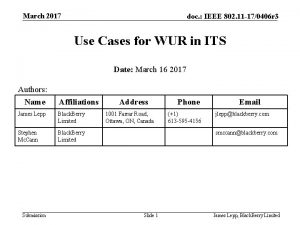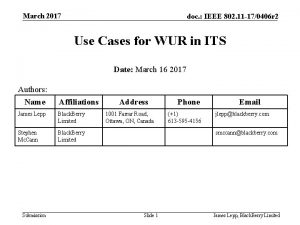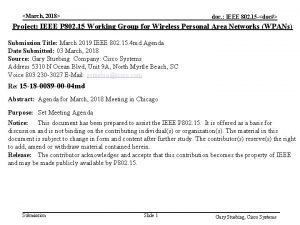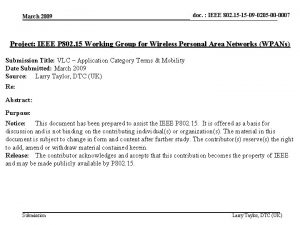March 2017 doc IEEE 802 11 170406 r







- Slides: 7

March 2017 doc. : IEEE 802. 11 -17/0406 r 11 Use Cases for WUR in ITS Date: March 2017 Authors: Name Affiliations James Lepp Black. Berry Limited Stephen Mc. Cann Black. Berry Limited Submission Address 1001 Farrar Road, Ottawa, ON, Canada Phone (+1) 613 -595 -4156 Email jlepp@blackberry. com smccann@blackberry. com Slide 1 James Lepp, Black. Berry Limited

March 2017 doc. : IEEE 802. 11 -17/0406 r 11 Background on 802. 11 ba (WUR) 802. 11 ba Wake-up Radio (WUR) is a low power mechanism to enable power saving in 802. 11 stations. In January 2017 it was decided to compile a Usage Model Document for 802. 11 ba. This presentation contains Use Cases for the 802. 11 ba task group to consider when designing the WUR protocol. Submission Slide 2 James Lepp, Black. Berry Limited. .

March 2017 doc. : IEEE 802. 11 -17/0406 r 11 Background on 802. 11 ITS systems 802. 11 -OCB (developed in 802. 11 p TG) is used as the basis of Intelligent Transportation Systems. Outside the context of a BSS devices transmit 802. 11 frames between vehicle onboard units (OBUs) and infrastructure roadside units (RSUs). Current 802. 11 -based ITS systems use a significant amount of energy to operate. To enable a third class of system for pedestrians and cyclists, as a group called vulnerable road users (VRUs), mechanisms to enable power saving are desired. Submission Slide 3 James Lepp, Black. Berry Limited

March 2017 doc. : IEEE 802. 11 -17/0406 r 11 Wake Up Vehicle-to-Pedestrian (V 2 P) Radio • Scenario • Pedestrian carrying portable device with V 2 P capability. • To conserve power, the V 2 P mode isn’t always operating. • Roadside infrastructure such as an intersection or an oncoming vehicle sends WUR wake-up trigger frame. • Pedestrian device wakes up and operates 802. 11 -OCB based V 2 P • Wakeup operation • ITS infrastructure sends WUR wake-up trigger frame • Pedestrian device wakes up and operates 802. 11 -OCB • Requirements • Low power and low latency Submission Slide 4 James Lepp, Black. Berry Limited

March 2017 doc. : IEEE 802. 11 -17/0406 r 11 WUR Vehicle-to-Pedestrian (V 2 P) • Scenario • Pedestrian carrying portable device. • Roadside infrastructure such as an intersection or an oncoming vehicle sends WUR wake-up trigger frame containing ITS information. • Wakeup operation • ITS infrastructure sends WUR wake-up trigger frame • Pedestrian device receives and decodes ITS related information in the WUR wake-up trigger frame • Requirements • Low power and low latency • WUR trigger frame contains small amount of data Submission Slide 5 James Lepp, Black. Berry Limited

March 2017 doc. : IEEE 802. 11 -17/0406 r 11 Additional thoughts • Previous power-saving mechanisms in 802. 11 were created with expense of high latency. • The combination of low power and low latency means WUR is capable of is applicable to more than just Io. T. • Can WUR be transmitted in the DSRC channels 172178 (aka 5. 9 GHz band) and used to enhance V 2 X communications. Submission Slide 6 James Lepp, Black. Berry Limited

March 2017 doc. : IEEE 802. 11 -17/0406 r 11 Straw Poll Should the 802. 11 ba task group consider intelligent transportation use cases for WUR? • Yes • No • Maybe Submission Slide 7 James Lepp, Black. Berry Limited













